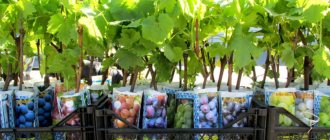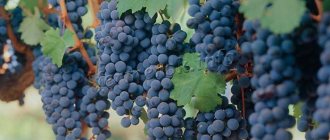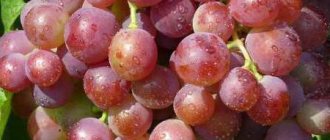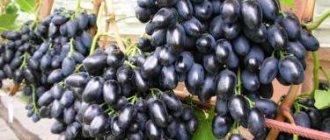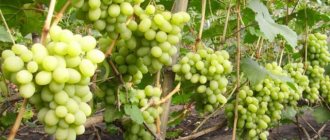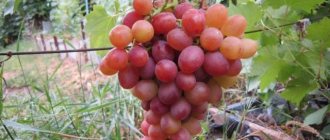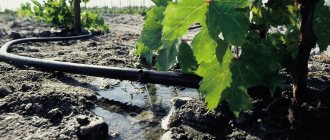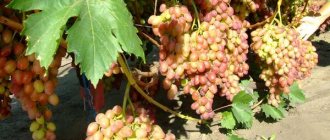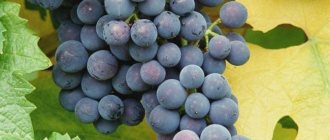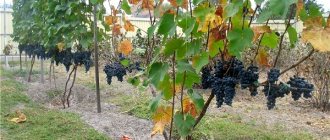Fruits and berries » Grapes
0
1046
Article rating
Kira Stoletova
Variegated grapes are one of the new varieties. It ripens early and is easy to care for, but to get a good harvest, you need to follow some rules for growing it.
Description of the Variegated grapes
Features of grapes
The “Motley” grape was bred under the guidance of amateur breeder S.E. Gusev. The variety was obtained by crossing such famous varieties as Kishmish radiant and Talisman. By combining the parent species of climbing shrubs, a completely new hybrid variety was created.
Its distinctive feature is its early ripening period.
Tests on yield and timing of yield were carried out in the Volgograd region. The roots feed well from the ground, while expelling young shoots at a rapid pace. This indicates excellent root growth vigor. The period of full ripening of the berries occurs during the growing season of 100-105 days from the moment the first young leaves bloom. This is almost 10 days earlier than the long-known early variety “Kodryanka”.
The flower of the grape is bisexual, that is, the shrub does not require close proximity to a specimen with a similar flowering period. The plant self-pollinates, subsequently producing solid harvests. The appearance of the bunch is represented by the usual appearance, but can sometimes be complemented by a protruding wing.
Ripe berries have a conical shape, elongated towards the end. The fruit itself is large, slightly oval, not exceeding 2.6 x 2.4 cm in size. The weight of each berry ranges from 8 to 10-12 grams. According to analyzes of the sugar content in the berry, a fairly high figure of 25% of the total content was obtained. Ripe berries have an original pink tint. Inside, the flesh is dense, fleshy, and when biting it produces a characteristic crunchy sound. The aftertaste gives off a memorable bright nutmeg taste. Connoisseurs of taste at the grape tasting gave it a score of 8.8 points.
Characteristics of the variety
The Motley grape variety was developed by breeder S.E. Gusev. It was obtained as a result of crossing Kishmish radiata and Talisman. The plant has a bisexual flower, so proximity to pollinators is not necessary. Characterized by early ripening. The berries ripen in about 100 days from the moment the first leaves appear. This is 10 days earlier than other known species.
The roots absorb nutrients from the soil well, thanks to which young shoots grow faster. Variegated grapes begin to wake up when the air temperature reaches 10°C. As the sap moves, the buds swell and leaves begin to grow.
- high fertility;
- average yield 130-150 c/ha;
- resistant to gray rot;
- used to form arches;
- average frost resistance;
- The shoots ripen well and bear fruit at 60-70%.
Description of the bush
According to the description, Motley’s bushes are medium-sized and vigorous. The leaves are medium in size, can be light green or deep green in color, have a heart-shaped shape and are medium cut. The top is smooth and shiny. They have an open petiole notch, without drooping of the lower part of the leaf. The lower notches on the side are shallow, with a small gap, the upper notches are oblong in shape.
Description of fruits
The length of the grape bunch reaches 40 cm. The approximate weight of the brush is 0.5 kg, but with good care it can reach 1 kg. The berries are medium in size, approximately 2.6 x 2.4 cm. The weight of one berry is 3-4 g. They have an oval, slightly elongated shape. The color of the ripe fruit is pink-red, the shade depends on the growing region.
The pulp is dense and juicy, with a nutmeg flavor. The amount of sugar in the berry is 20-25%, the acidity of the juice is 6-7 g/l.
Motley
| Ripening period | very early (100-105 days); |
| Flower functionality | bisexual; |
| Bunch weight | 800-1500 g; |
| Berry weight | 8-12 g; |
| Taste | nutmeg aroma; |
| Bushes | medium height; |
| Frost resistance | -23ºС; |
| Disease resistance | above average. |
The real discovery of the season was the hybrid form of Gusev Sergei Eduardovich Motley. I was surprised, first of all, by its taste; here we have the brightest nutmeg with fruity tones and all this against the backdrop of a bright color and very early ripening. There are no huge berries that everyone is used to, but large clusters and good yield make this form promising for berry growers.
- Origin of Motley
- Main characteristics
Origin of Motley
Has a parent pair Talisman on Kish-mish radiant. This combination can already be considered a classic, used by many breeders and from which we have received many beautiful forms and varieties. The genes of Talisman, as a representative of the Vostorgov group, convey the characteristics of stability and large berries. Radiant is responsible for the color of berries and taste.
Of course, many of Gusev’s forms are lost against the background of his bestseller Dubovsky Pink, but Motley can also be considered one of his best creations. When the berries are “ignited,” you can see veins that disappear when they are fully colored. Apparently this gave the name to this form.
Main characteristics
The ripening period for the first fruiting of an already mature bush with a good load falls on the first days of August, however, nutmeg appears much earlier.
The clusters are large and very large, of medium density, weighing 800-1500 grams.
The berry is large, about 8-12 grams, rich pink-red color, oval. It is the bright color that attracts any visitor to the vineyard. The pulp is dense, fleshy with a crunch when biting.
The taste is very bright and rich with a nutmeg aroma. Currently one of the most memorable in the vineyard. Capable of good sugar accumulation up to 25% brixx. Tasting scores are very high.
The crop can hang on the bush for a long time without losing its marketability and taste. Muscat remains, the color remains bright pink, unlike many forms whose color fades to dark tones.
Bushes of medium vigor in the rooted version, using vigorous rootstocks, it is possible to increase the vigor of growth, as well as change other parameters.
Disease resistance is good. Enough preventive treatments. Frost resistance down to -23ºС.
Motley (Guseva S.E.) - characteristics of g.f. grapes
Variegated - table grape variety (g.f.) of very early ripening
Originator: Gusev Sergey Eduardovich, Dubovka, Russia
Parent pair: Talisman x Kishmish Radiant
Origin: complex interspecific hybrid
Description and main characteristics: Variegated is a new hybrid form of grapes privately selected by Gusev S.E. Grafted and self-rooted bushes have above average growth vigor, the flower type is bisexual. The clusters are conical, of moderate density, sometimes with a wing, of medium size, weighing 350-450g. The berries are ovoid, beautiful pink in color, with an average weight of 7-8g, individual up to 10g. The skin is thin, you can’t feel it when eating, the flesh is dense, crispy, with a pronounced, very pleasant nutmeg. Sugar accumulation is more than 20%. The vine ripens well, cuttings take root easily. Medium pruning of fruit vines to 7-8 buds is recommended. Disease resistance is being studied. The variety is grown in a cover culture. Description is preliminary. According to available reviews from winegrowers, the actual ripening period does not correspond to that originally stated by the originator. The form loses acid early and becomes edible in early August with low sugar content, but acceptable consumer maturity occurs in the second ten days of August. The Variegated variety stands out for its very beautiful coloring of berries and excellent taste; other characteristics require more careful study and addition.
Reliance pink seedlis grapes - description of the variety, photos, reviews, video.
A seedless table grape variety of American origin.
Obtained in 1964 from an experimental vineyard at the University of Arkansas. In 1968, the resulting seedlings were propagated vegetatively and tested in Arkansas and at state agricultural experiment stations in Ohio, Texas, Wisconsin and North Carolina.
Tests have shown that the new variety is widely adapted to various climatic and soil conditions. The plants are very winter-hardy and survived and produced fruit for 8 consecutive years in Sturgeon Bay, Wisconsin, where winter temperatures dropped to -34°C.
It has proven itself well when grown, both on its own roots and in a grafted state. Self-rooted plants grew poorly only in the calcareous soils of southwest Texas.
Became a variety in 1982, patent #5174.
Description of grapes Reliance Pink Seedlis
Very early ripening period, 105-110 days at CAT 2250-2350°C, ripens in early August.
Frost resistance: up to -34 degrees (according to the originator). In Russian-language sources there is a figure of -27 degrees.
Name in the language of the country of origin: Reliance seedless.
International name: Reliance seedless.
Si nonims: Reliance pink seedless, RPS.
Originator: University of Arkansas, USA.
Parents: Ontario x Suffolk ed.
Old leaves near the base of the shoots are dark green (137B) on the upper surface and gray-green (194B) on the lower surface. Young leaves near the tip of the shoots are yellow-green (144B) on the upper surface and gray-green (196C) on the lower surface.
The flower is bisexual. The stamens are medium and straight. Pistils are of medium length. Pollen is normal. The type of seedlessness is stenospermocarpy.
The clusters are cylindrical-conical, moderately dense, weighing 180-220 g, according to the originator up to 300 g.
The berries are small, 1.4-3 g, greenish-pink in color, round, pleasant taste, with a light strawberry aroma (labrusca aroma). Seedless category I, the rudiments are very small, practically not felt when eating, the flesh is juicy, melting, the skin is strong, thin, separated by a pouch. The berries are prone to cracking in wet weather during ripening. The tasting score for fresh grapes is 7.4 points, for dried products 7.6 points. When stored cold, the berries will last up to 3 months.
Sugar accumulation is 21-22%, according to the originator up to 24%. The acidity of the juice is 6-7 g/l.
Resistant to major fungal diseases of grapes. Resistance to mildew is 3.5 points, to oidium - 3.5-4 points. Moderately resistant to black rot, anthracosis, powdery mildew and mold.
Relines Pink Seedlis has good affinity with Kober 5BB rootstock
The vine ripens well, more than 80%. The cuttings take root well.
Fruitful shoots up to 45%, fruiting coefficient 1.9. Load 45-50 eyes. With a planting pattern of 3 x 1.5 m, trim to 6-8 buds. The average yield is 120-150 c/ha.
Suitable for growing in uncovered crops.
Photo of Relines Pink Seedlis grapes
Reviews from winegrowers about Reliance Pink Seedlis grapes
“I really liked this variety. Not painful, pulled out the entire harvest. It hangs for a very long time!” (Vadim, Rostov-on-Don, Russia)
“The vine ripens almost completely. The resulting brushes weigh about 400 grams (I use gibberellin to enlarge the berries). I didn’t notice any signs of disease on the leaves. Literally a few berries on the entire bush can spoil on the bunches. The harvest can hang for a long time, but over time (3 weeks after ripening), the ridges begin to dry out and some of the berries may begin to crumble. The harvest is dried for raisins, but for some reason they turn out sticky, unlike raisins from other grape varieties.” (Da4nick, Klin, Moscow region, Russia)
“The bunches are beautiful, much larger in size, the yield was 3-4 kilograms, I didn’t get sick with anything, the berries didn’t break after the rains. But this does not change the fact that this is just Lydia without seeds” (Alekseychuk Ivan, Ukraine)
“The size of the bunch is the size of a matchbox, good only for Canada, it froze in my place without shelter for the 3rd winter” (Stavropol, Russia)
Video reviews of Reliance Pink Seedlis grapes
Buy Reliance Pink Seedlis grape seedlings from our partners in Russia
Buy Reliance Pink Seedlis grape seedlings from our partners in Ukraine
If you grow Reliance Pink Seedlis grapes, send us your review or photo, we will post your review or photo in this article with attribution to the author (optional). Additionally, we can add a link to your website/social network to contact you or other contact information.
Preparing for landing
Planting works well in both well-lit and shady places
At the same time, it should be taken into account that in order to observe the magnificent autumn color of the perennial maiden grapes with the arrival of cold weather, cultivation should take place in a sunny area
Tripointed maiden grapes
When planting is carried out near a support on the north side, the crop retains its green color until the winter leaves fall. Another advantage that accompanies cultivation on the southern and eastern sides is faster propagation and the formation of comparatively larger leaves.
Sowing seeds in open ground is carried out in the fall, and planting seedlings is also carried out in the spring. The plant has no special preferences for the composition of the soil. But virgin grapes are particularly successful when grown in specially prepared soil mixtures. To do this take:
- 2 parts of garden land;
- 2 parts compost;
- 1 part sand.
All components are thoroughly mixed and the resulting substrate is filled with planting holes for cuttings.
Planting seedlings
At the same time, preparatory work is carried out on the holes for planting grapes:
- a month before planting, dig holes measuring 0.8 x 0.8 m;
- The bottom of the holes should be filled with a mixture of humus and compost;
- a layer of fertilizers and ash is placed on top of the substrate, which is sprinkled with earth up to 2/3 of the volume of the hole;
- in this form, it is necessary to leave the holes for a month so that the soil is saturated with useful microelements;
- after four weeks, ready-made seedlings of the Motley variety are planted in holes;
- for watering, a plastic pipe is placed next to the bush, protruding 15-20 cm above the surface;
- when planting grapes, you need to carefully straighten the roots of the seedlings and cover them with soil, thoroughly compacting it;
- Tamp the tree trunk well and water well with warm water.
Motley grapes: variety description, photos, reviews
Variegated grapes are one of the new varieties. It ripens early and is easy to care for, but to get a good harvest, you need to follow some rules for growing it.
Description of the Variegated grapes
Characteristics of the variety
The Motley grape variety was developed by breeder S.E. Gusev. It was obtained as a result of crossing Kishmish radiata and Talisman. The plant has a bisexual flower, so proximity to pollinators is not necessary. Characterized by early ripening. The berries ripen in about 100 days from the moment the first leaves appear. This is 10 days earlier than other known species.
The roots absorb nutrients from the soil well, thanks to which young shoots grow faster. Variegated grapes begin to wake up when the air temperature reaches 10°C. As the sap moves, the buds swell and leaves begin to grow.
Features of the variety:
- high fertility;
- average yield 130-150 c/ha;
- resistant to gray rot;
- used to form arches;
- average frost resistance;
- The shoots ripen well and bear fruit at 60-70%.
Description of the bush
According to the description, Motley’s bushes are medium-sized and vigorous. The leaves are medium in size, can be light green or deep green in color, have a heart-shaped shape and are medium cut. The top is smooth and shiny. They have an open petiole notch, without drooping of the lower part of the leaf. The lower notches on the side are shallow, with a small gap, the upper notches are oblong in shape.
Description of fruits
The length of the grape bunch reaches 40 cm. The approximate weight of the brush is 0.5 kg, but with good care it can reach 1 kg. The berries are medium in size, approximately 2.6 x 2.4 cm. The weight of one berry is 3-4 g. They have an oval, slightly elongated shape. The color of the ripe fruit is pink-red, the shade depends on the growing region.
The pulp is dense and juicy, with a nutmeg flavor. The amount of sugar in the berry is 20-25%, the acidity of the juice is 6-7 g/l.
Growing grapes
The grapes are unpretentious to grow, but there are some rules. It is better to plant bushes on the south side, they need a lot of sunlight. When grown in the shade, growth retardation and lack of fruit may occur.
Drop off rules:
- choose places for planting that are protected from drafts;
- prepare support for seedlings in advance;
- plant the bushes next to a fence or wall, which, when heated, will give heat to the plant;
- Be sure to thin out the bushes so that they receive the required amount of light.
Any type of soil is suitable for growing, including rocky soil. This species grows well on sandstones. When grown in black soil, the roots will be close to the surface because there is no need to search deeper for water and nutrients.
Planting in the soil
It is advisable to plant a young plant in April or May
The Variegated grape variety is best planted from spring to autumn at any time. A plant that is no more than 1 year old will take root better when planted from April to the end of May. Seedlings that are more than a year old are planted in the summer. When planting in autumn, more careful care is required.
A month before planting the seedling, dig a hole 0.8 x 0.8 m and lay the bottom with humus and compost, and spray ash fertilizer on top. The pit is left in this form for a month so that all the beneficial substances are absorbed into the soil.
A month later, the seedlings are planted. The roots are spread well, covered with soil, compacted and irrigated abundantly. For more efficient watering, install a pipe next to the bush; it should protrude 20-25 cm above the ground. This way, when irrigated, water will flow directly to the roots.
Plant care
In spring, even temperatures of 1-2° have a bad effect on bushes. In autumn, mature plants can withstand cold temperatures down to -10°, and in winter - down to -15-20°. To protect the bushes from frost, pre-planting soil treatment is used, as is the quotation of young and fruit-bearing bushes.
The above-ground part of the plant is covered. If the average air temperature drops below -15-16°, the bush is completely covered.
For good fruiting, the Variegated variety needs sufficient light. To ensure it, they prune stepsons and barren shoots, tie up annual shoots and form the correct shape of the bushes.
Fertilizer
Applying fertilizers to the hole during planting ensures good growth for 3-4 years. But the land is gradually depleted and there is a need for feeding.
The composition of the fertilizer depends on the growing season:
- in the spring, nitrogen is added to increase the amount of green mass;
- at the beginning of flowering, phosphorus fertilizers will be useful;
- To prepare plants for winter, add potassium salt.
Fertilize not only with mineral fertilizers, but also with compost or manure. They promote better breathability and provide the necessary minerals.
Watering
The Variegated variety is watered only with settled water, preferably in the evening. Irrigation with warm water will speed up bud break in the spring. The frequency of watering during the growing season is adjusted depending on the weather and the condition of the plants. Combining irrigation and fertilizing will be effective.
Before the onset of winter, water the bushes abundantly. This will protect against cold penetration into dry soil. Irrigation will prevent soil freezing and provide moisture for the future growing season. But if the autumn was not dry, there is no need to water.
Diseases and pests
The plant is resistant to diseases
According to the description, this species resists diseases and pests well. It is rarely susceptible to gray rot and oidium. But sometimes Motley can be infected with the following diseases:
Some insect pests that are dangerous for Variegated grapes:
- spider mite;
- grape mite;
- cluster leaf roller.
Disease Control
Anthracnose occurs due to excess moisture. Rotten spots and voids appear on the leaves. The berries begin to crack and disappear in whole bunches. To overcome the disease, periodically prune the vine, removing all damaged parts. Spray with Acrobat or Ridomil.
Apoplexy is an incurable disease. The bush is withering and cannot be saved. Only proper care will help prevent the onset of the disease.
Pest Control
The leaf roller is one of the most common types of pests. To combat it, insecticides are sprayed.
When infested with spider mites, the foliage begins to curl and fall off. Only fighting with chemicals will help. In case of a grape mite attack, only spraying with Nitrafen and Actellik will be effective.
Prevention
Prevention includes timely pruning, drainage watering, proper fertilizing and watering.
Conclusion
The Variegated variety has become popular among gardeners due to its early ripening and pleasant taste of the fruit. It is easy to grow and care for. To get a good and healthy harvest, adhere to the correct planting of seedlings and provide timely care for the crop.
Source: https://FermoVed.ru/vinograd/pestryj-opisanie.html
Growing grapes
The grapes are unpretentious to grow, but there are some rules. It is better to plant bushes on the south side, they need a lot of sunlight. When grown in the shade, growth retardation and lack of fruit may occur.
- choose places for planting that are protected from drafts;
- prepare support for seedlings in advance;
- plant the bushes next to a fence or wall, which, when heated, will give heat to the plant;
- Be sure to thin out the bushes so that they receive the required amount of light.
Any type of soil is suitable for growing, including rocky soil. This species grows well on sandstones. When grown in black soil, the roots will be close to the surface because there is no need to search deeper for water and nutrients.
Planting in the soil
It is advisable to plant a young plant in April or May
The Variegated grape variety is best planted from spring to autumn at any time. A plant that is no more than 1 year old will take root better when planted from April to the end of May. Seedlings that are more than a year old are planted in the summer. When planting in autumn, more careful care is required.
A month before planting the seedling, dig a hole 0.8 x 0.8 m and lay the bottom with humus and compost, and spray ash fertilizer on top. The pit is left in this form for a month so that all the beneficial substances are absorbed into the soil.
A month later, the seedlings are planted. The roots are spread well, covered with soil, compacted and irrigated abundantly. For more efficient watering, install a pipe next to the bush; it should protrude 20-25 cm above the ground. This way, when irrigated, water will flow directly to the roots.
Plant care
In spring, even temperatures of 1-2° have a bad effect on bushes. In autumn, mature plants can withstand cold temperatures down to -10°, and in winter - down to -15-20°. To protect the bushes from frost, pre-planting soil treatment is used, as is the quotation of young and fruit-bearing bushes.
The above-ground part of the plant is covered. If the average air temperature drops below -15-16°, the bush is completely covered.
For good fruiting, the Variegated variety needs sufficient light. To ensure it, they prune stepsons and barren shoots, tie up annual shoots and form the correct shape of the bushes.
Fertilizer
Applying fertilizers to the hole during planting ensures good growth for 3-4 years. But the land is gradually depleted and there is a need for feeding.
The composition of the fertilizer depends on the growing season:
- in the spring, nitrogen is added to increase the amount of green mass;
- at the beginning of flowering, phosphorus fertilizers will be useful;
- To prepare plants for winter, add potassium salt.
Fertilize not only with mineral fertilizers, but also with compost or manure. They promote better breathability and provide the necessary minerals.
Watering
The Variegated variety is watered only with settled water, preferably in the evening. Irrigation with warm water will speed up bud break in the spring. The frequency of watering during the growing season is adjusted depending on the weather and the condition of the plants. Combining irrigation and fertilizing will be effective.
Before the onset of winter, water the bushes abundantly. This will protect against cold penetration into dry soil. Irrigation will prevent soil freezing and provide moisture for the future growing season. But if the autumn was not dry, there is no need to water.
Planting a seedling
Planting of young seedlings of “Motley” can be done in both autumn and spring. If there is an annual sprout with a lignified trunk, then it can be rooted in early April, until the end of May. From the beginning of summer until the last days of August there is an opportunity to root green young stepsons.
You can also root in the fall, but in this case it is necessary to carefully prepare the seedling for wintering. For these purposes, the soil around the cutting is covered with sawdust, peat or pine needles. This is also necessary to prevent rodents or other pests from damaging the bark of the sprout in winter. If the upper layers are damaged, the young animals may get sick or even die from sudden temperature changes.
Only healthy young vines are taken for planting. To ensure the quality of planting material, a visual examination of the cuttings is carried out:
- When cutting a seedling, the white inner flesh should be visible at the base of the cut. If the cutting has brown content under the bark, it should be thrown out or burned. This seedling is sick and unsuitable for planting.
- If you take a cutting that was placed for rooting a year ago, then it should have a mature cut, giving off a bright green tone.
- A healthy cutting can be checked by the quality of its buds. If they do not fall off the stem when touched, this indicates the suitability of the seedling.
Rules and features of landing:
- Before a sprout is planted in open ground, it must undergo a certain procedure. The cutting is cut so that only two internodes remain on the body of the vine. Moreover, it is required that the lower node is located at a distance of 1-1.5 cm from the end of the cutting, and the upper one is located 2 cm lower from the upper cut.
- Exactly 24 hours are required to soak the stepson before planting in a growth activator. This can be either the chemical drug Kornevin or a spoonful of honey diluted in water.
- After soaking, both sections are treated with garden pitch or paraffin. This is necessary so that by placing them in a cold room for a month, harmful bacteria and uninvited guests in the form of parasites do not settle inside the trunk.
- The next stage is planting in a container for root germination.
- For planting, dig a hole in the ground to a depth of 80 cm; the width should be the same. A mixture of humus and fertile substrate is placed at the bottom.
- The next layer is laid out with mineral fertilizers in the form of potash fertilizer (300 g), wood ash (1 l.), superphosphate (300 g.). Next, half of the excavated soil is laid out. The total volume of the pit should be occupied by an average of 50 cm.
- In this state, the recess is left for 1 month to be completely saturated with nutrients.
- After the set time has passed, the prepared cuttings of the “Motley” grapes should be planted. Its roots should be straightened and covered with a dense layer of the remaining soil.
- The soil must be thoroughly compacted and watered abundantly.
Read also: Golden autumn raspberry description and care
Features of the plant
The plant received its name virgin ivy due to its ability to form fruits without pollination. This perennial crop has inconspicuous flowering, and its fruits are not eaten. Its main advantage, which is used with pleasure in landscape design, is its dense decorative foliage.
The palmate leaves are bright green in color. With the arrival of cold weather, the greenery begins to turn purple, and until winter, the garden plot will be decorated with foliage in red and purple shades.
Ripe fruits of virgin grapes
It is better to choose a place in the open ground for growing grapes near a vertical support, so that the vines have room to grow. If you do not prune from time to time, this perennial crop will fill all available space. This feature is used in landscape design to disguise unattractive outbuildings, as well as untreated walls of houses. Another useful quality of the plant is its ability to improve the microclimate, inhibiting the development of certain pathogens.
How to grow Motley grapes correctly?
Grapes are a crop that almost all gardeners want to grow. It can be planted both to produce a harvest and to decorate a decorative structure in the form of a gazebo or an enclosed corner of the garden. One of the new varieties developed not so long ago is the “Motley” grape. Many cultural connoisseurs are not yet familiar with it, so it’s worth getting to know it better.
Care Tips
In order for the “Motley” grapes to develop qualitatively, grow quickly and produce abundant harvests, it is necessary to follow several rules for its care:
- In early spring, it is necessary to carry out a dry garter - for this it is necessary to carefully tie all the shoots that grew last year to a trellis or support.
- At the beginning of March, excess shoots are pruned. In autumn, pruning is carried out only as a preventive measure against diseases. Full pruning must be done in the spring. After winter, you need to trim off frozen or damaged shoots.
- Perform pinching. It is recommended to perform the procedure one week before flowering. This action provokes the growth of axillary buds, thereby the bush begins to branch rather than stretch out a single shoot.
- Regulate the number of inflorescences. In order for the harvest to be high-quality and large, you should break off excess clusters with impending flowering. The bush will not waste energy on growing small berries, but will direct it to a smaller volume.
- Periodically remove unnecessary leaves. During the period of berry ripening, it is necessary to clear thickets of leaves. They prevent sunlight from penetrating the grapes. Thereby depriving the fruit of sweetness.
- It is required to apply periodic fertilizing - at the beginning and after flowering, before ripening.
Thus, in order to achieve good results at the end of the fertile season, you should not be lazy and let the development of an interesting grape variety take its course. If you carry out simple activities, then the grapes will delight you with large and juicy berries.
Care Tips
In order for the “Motley” grapes to develop qualitatively, grow quickly and produce abundant harvests, it is necessary to follow several rules for its care:
- In early spring, it is necessary to carry out a dry garter - for this it is necessary to carefully tie all the shoots that grew last year to a trellis or support.
- At the beginning of March, excess shoots are pruned. In autumn, pruning is carried out only as a preventive measure against diseases. Full pruning must be done in the spring. After winter, you need to trim off frozen or damaged shoots.
- Perform pinching. It is recommended to perform the procedure one week before flowering. This action provokes the growth of axillary buds, thereby the bush begins to branch rather than stretch out a single shoot.
- Regulate the number of inflorescences. In order for the harvest to be high-quality and large, you should break off excess clusters with impending flowering. The bush will not waste energy on growing small berries, but will direct it to a smaller volume.
- Periodically remove unnecessary leaves. During the period of berry ripening, it is necessary to clear thickets of leaves. They prevent sunlight from penetrating the grapes. Thereby depriving the fruit of sweetness.
- It is required to apply periodic fertilizing - at the beginning and after flowering, before ripening.
Thus, in order to achieve good results at the end of the fertile season, you should not be lazy and let the development of an interesting grape variety take its course. If you carry out simple activities, then the grapes will delight you with large and juicy berries.
Interview with national breeder Sergei Eduardovich Gusev
Gusev Sergey Eduardovich is a winegrower and folk breeder living in the city of Dubovka, Volgograd region. He is known to many for having developed one of the most harmonious grape varieties in taste, color and size - Dubovsky pink. This is not the first year that this has been the most famous variety among winegrowers. However, the breeder still has many breeding achievements in his arsenal, which are now successfully undergoing variety testing.
– Sergey Eduardovich, which varieties of your selection do you consider the best and why?
– Of course, Dubovsky pink. He is the most famous and one of the best. The Motley variety is a little less known. In my opinion, it is even better than Dubovsky pink. The variety is very early and of high quality, with luxurious nutmeg and special fruit tones. To receive it is truly a great success. I brought him out in 2009 and he is still in the best standing.
The best of the black varieties I received is Timati. Mainly due to the early ripening period and very large berries. And the taste doesn't disappoint.
Help from Sergei Gusev
By the way, Timati and Dubovsky red (this is not a typo, in addition to Dubovsky pink there is also Dubovsky red with a spindle-shaped berry) took first places at the conference of winegrowers in Krasnodar.
– In general, I have bred more than fifty varieties. They seemed really good. But some varieties had peas, some had a lot of seeds in the berries, some burst in rainy years. A lot of people have been eliminated, and now only the good ones remain in the “clip.” Their names and descriptions are easy to find on the Internet.
– Have you submitted your varieties for variety testing or not?
“Pied and Dubovsky pink are already being tested.” Ten more varieties will be available this year. But this is not a quick process and takes at least five years. Not to mention the fact that you also have to pay money for this from the family budget. Nevertheless, it is necessary to conduct variety tests, and I cooperate with institutes.
– What varieties would you advise beginners to start with?
– In my opinion, Dubovsky pink is simpler and more reliable than many, not to mention its high commercial qualities.
– Some people say that his brushes are inconspicuous and small?
– The smallest brush is 1200 g, and there are also two and three kilograms. However, a large brush is not very good. It is very difficult to sell a brush for 500 rubles, and it is not easy to eat it yourself, not to mention the difficulty of transportation. I generally consider 600-800 g to be the golden mean.
– What direction in selection did you choose?
– Just early varieties, I try to use more resistant forms. True, this is a thankless job. Most seedlings do not repeat their mother’s qualities, trying to return “to their grandparents,” that is, to inconspicuous small green berries with a mediocre taste.
He sowed from 5,000 to 10,000 seeds and selected no more than one from them. Now I can’t sow so much, but still the selection is serious. Getting a good variety is real luck.
– How do you feel about Chinese and Japanese varieties?
– I have everything in my collection, they look nondescript, faded. The berry sizes are much smaller than in Japan and China. Because they stuff them with all sorts of nasty things, that’s why they’re sick. And in Russia, without stimulants, it’s better not to mess with them. The exception is Finger Manicure: it is very beautiful. But in our conditions it has very low yield.
I got an interesting seedling, so far I named it Banana Legs. Because it really looks like a banana, without any chemicals. But it only bore its first fruit. I really like it so far. We still need to keep an eye on him.
– Do you cover your vineyard for the winter? If yes, then how...
- We definitely cover it with earth and bury it. Seven of us cover a hectare in a day. There is, of course, a drawback - the protection of the roots is weakened and they can freeze.
– Do you have phylloxera, how do you fight it?
– I don’t, we have sandy soils. Phylloxera, in order to leave offspring, climbs into the soil. And grains of sand have sharp edges. The phylloxera cuts its carcass on them and dies. No one here has phylloxera.
– What fungicides do you use in your vineyards?
– Convertible top. In my opinion, there is no better one. Or rather, it’s better, but the price is an order of magnitude higher, so I don’t see the point in taking something else. Cabrio top kills both mildew and oidium, and disease resistance does not develop to it.
– How do you fight pests?
– Ticks happen, and not every year. We spray it with Fitoverm.
The interview was conducted by Andrey Lozovoy
Growing conditions
The development of grapes begins in early spring, when the air temperature warms up to plus 8-10C. This moment is characterized by swelling of growth buds, active sap flow and leaf opening. The most optimal temperature for “Motley” grapes, when the shoots are actively growing, the formation of flower ovaries and the appearance of fruit clusters begins, is fixed at +15-+30 C. If the temperature drops to +10 C and below, the development of the bush slows down significantly or stops altogether.
The shrub should be planted in a well-lit place, where there is a lot of sunlight and no cold drafts.
If you place the bush in a darkened area, you may not get a harvest at all. It is advisable to plant on the south side or under the wall of a building. This will protect the plant from heat loss. A support or arbor is formed immediately under the young grapevine. To ensure that the overgrown plant receives maximum sunlight in all corners and places, pruning is carried out periodically. It allows you to thin out overgrown bushes, free the bunches, creating conditions for them to ventilate and receive enough sunlight.
The “Motley” grape is not distinguished by its capricious disposition; it grows well on sandy soils and can also get along well on rocky substrates. When planted on chernozems, it develops a fibrous root system that branches well. In such conditions, the roots do not need to go into the ground to search for nutritious moisture. The rhizomes are located almost on the surface of the soil.
Diseases and pests
The plant is resistant to diseases
According to the description, this species resists diseases and pests well. It is rarely susceptible to gray rot and oidium. But sometimes Motley can be infected with the following diseases:
Some insect pests that are dangerous for Variegated grapes:
- spider mite;
- grape mite;
- cluster leaf roller.
Disease Control
Anthracnose occurs due to excess moisture. Rotten spots and voids appear on the leaves. The berries begin to crack and disappear in whole bunches. To overcome the disease, periodically prune the vine, removing all damaged parts. Spray with Acrobat or Ridomil.
Article on the topic: Chersonesos - Crimean grape variety
Apoplexy is an incurable disease. The bush is withering and cannot be saved. Only proper care will help prevent the onset of the disease.
Pest Control
The leaf roller is one of the most common types of pests. To combat it, insecticides are sprayed.
When infested with spider mites, the foliage begins to curl and fall off. Only fighting with chemicals will help. In case of a grape mite attack, only spraying with Nitrafen and Actellik will be effective.
Prevention
Prevention includes timely pruning, drainage watering, proper fertilizing and watering.
MAIN CRITERIA FOR SELECTION OF TECHNICAL VARIETIES OF GRAPES
Frost resistance of grapes
In the area of covered viticulture, all varieties that winter safely with standard air-dry cover are suitable. Therefore, the required minimum resistance of grapes to winter frosts is from -25...-26 °C.
Grape ripening period
The ripening period of berries for techies is a separate issue, since good “techies” very rarely have very early and early varieties in the north. We try to select technical grape varieties that ripen in our area, but, if possible, as late as possible, so that the grapes have time to take as much warmth, aroma and sweetness from nature during the growing season.
Ripening of the grapevine
When choosing varieties, be sure to pay attention to the period and quality of ripening of the grapevine, otherwise the grapes will not survive the winter
Grape disease resistance
Technicians, as a rule, need less treatment for fungal diseases than table varieties. In addition, varieties of domestic and foreign selection that are complexly resistant to fungal diseases have appeared - Bruscam, Augusta, Cabernet Noir, Cabernet Jurai, etc. As mandatory preventive measures, use biological control methods and/or, if you are not committed to completely organic vineyard management , permitted copper and sulfur-containing preparations.
Wine quality
Techie berries are usually very juicy, with a juice yield of 65–80%. The sugar content of grape juice is measured as a percentage, titratable acidity is measured in grams per liter. When ripe, techie berries have a high sugar content (18–20% or more), which is 1.5 or even 2 times higher than that of table varieties.
Grape yield
Don’t expect to get high-quality wine material by the cart without increasing labor costs and the size of plantings in the vineyard. Especially if you focus on European varieties and hybrid forms. But the variety should produce some minimum reasonable yield
In a technical vineyard, it is important to tune in to the quality of the grapes, not their quantity. The optimal yield for red varieties with frequent (up to 1 m) planting is 2.5–3 kg per vine, for white varieties – up to 5 kg. Therefore, yield normalization for technical varieties is simply necessary
The first of them is carried out in the third ten days of June at the “pea” stage. Depending on the variety, we remove 30–50% of the brushes. We are not greedy, but we still count on a reasonable minimum harvest. So, for example, the early light-berry varieties of universal use Dublyansky (Ukraine), Somerset Seedlis (USA), Siegerrebe (Germany) are interesting in taste and resistant to diseases, but their yield is too low and unstable. If you have a desire to make wine from varieties that produce not 2-5 kg per bush (vine), but many (!) kilograms of grapes, without obvious deterioration in quality, then engage in variety testing of Amur varieties and some French-American hybrids.
The versatility of grape varieties
Technical grape varieties are universal in use, as they are suitable not only for juices and wines, but also for food and cooking, for drying for raisins and for processing for medicinal purposes. And most are very tasty!

